Structure Of The Earth
Physical
geography can be simply defined as the study of the structure of the
Earth and the forces which affect it. These forces are categorized into
two kinds: internal and external forces. Internal forces
are forces which act within or beneath the Earth‘s crust. These forces
result into various Earth movements such as vertical and horizontal
movements, vulcanicity and earthquakes. External forces
are forces which act inside the earth‘s surface and result into various
geomorphic processes such as mass wasting and weathering. The earth is
composed of inner and outer zones (layers). The outer layer of the earth
comprises of the atmosphere, biosphere and hydrosphere, while the inner
layer includes the crust, mantle and core
Concentric Zones of the Earth
Identify concentric zones of the earth
The earth is composed of three internal, concentric layers of increasing densities. These layers are the crust, mantle and core.
They are made up of different layers of rocks, with their densities
increasing towards the centre of the earth. That is, densities of rocks
that make up the earth increase as you move from the surface towards the
interior
The Crust (Lithosphere)
This
is the outermost part of the earth. It consists of silica and aluminium
(sial). It forms the upper layer of the continent and is mostly
composed of granite rocks. The layer below SIAL is called SIMA. This
layer is made of silica and manganese. It is a layer of basaltic rocks
which are denser and underlies the continental block to form the ocean
floor.
The Mantle (Mesosphere)
This
is the layer below the crust. It is composed of iron and manganese. It
lies between the crust and the core. The layer which separates crust and
mantle is called Mohorovic discontinuity. The mantle is made up of very
dense and hot igneous rocks, found in semi liquid states. It extends
downwards 2900 km and the temperature ranges between 5000°C and 7000°C.
The density of the mantle is 3 – 3.3 g/cm3. It is divided into two parts
namely, the upper and lower mantle. The upper mantle is rigid and
combines with the crust to form a layer called lithosphere. Below the
upper mantle there is a layer called asthenosphere
The Core (Barysphere)
This
is the innermost layer of the earth. It is composed of nickel and iron.
Its diameter is approximately 2500 – 2700 km and its temperature is
around 5500°C. The average density of the barysphere is about 5.2 g/cm3.
Most geographers believe that the core is divided into solid and liquid
core. The total mass of the earth is about 5.976 x 1021 tonnes.
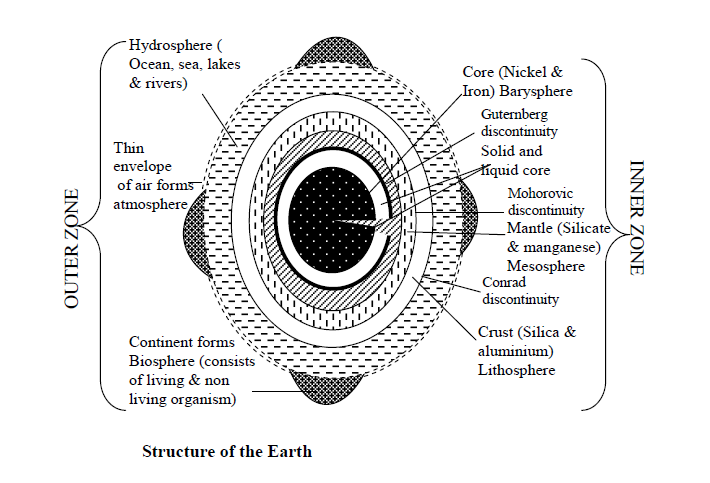
Structure of the Earth
The Variation in Density and Thickness of the Concentric Zones of The Earth's Crust
Account for the variation in density and thickness of the concentric zones of the earth's crust
ROCKS
A
rock is an aggregate of mineral particles found in soft, solid or
unconsolidated state. The earth‘s crust consists of rocks and rocks
consist of a combination of different minerals. All minerals are formed
from one or more of eight main elements. These are: oxygen, silicon,
potassium, sodium, calcium, magnesium, iron and aluminium.
Rocks
can be broadly categorized into three types. These are igneous rocks,
sedimentary rocks and metamorphic rocks. These kinds of rocks are
classified according to their origin, chemical composition and age.
The Characteristics of The Earth's Crust, The Mantle and The Core
Variations
in characteristics of the three interior zones of the earth are the
result of temperature and pressure as they increases from the surface to
the center of the earth.Factors which accounts for such variations
includes: pressure on the underlying materials, weight of the underlying
materials, radioactivity, magma movement and heat generated during the
formation of the earth.
The Types of Rocks of the Earth's Crust
Igneous rocks
These
rocks are formed when molten rock cools and solidifies. All igneous
rocks originate inside the earth where they are under great pressure.
Igneous rocks do not occur in layers and they don‘t contain fossils
which are the chemically-changed remains of ancient plants and animals
embedded in rocks. These rocks solidify either within the earth‘s crust
and form intrusive features or outside the earth‘s surface and form
extrusive features.
Igneous
rocks are formed when the molten magma is forced out from the upper
mantle to the earth‘s surface, where it cools and solidifies due to low
temperature. Crystals form on cooling and the rocks are called
crystalline rocks.
There are two main types of igneous rocks:
- Plutonic: these have solidified deep in the crust and they are seen on the surface only after being exposed by prolonged erosion.
- Volcanic: these have been poured on the earth‘s surface where they are called lavas.
Characteristics of igneous rocks
- Igneous rocks reflect light.
- They are not found in layers.
- They do not contain fossils.
- They are crystalline rocks.
- They are formed through cooling and solidification of magma.
- They can undergo metamorphic and weathering processes.
- They contain different minerals like iron, magnesium etc.
Many
igneous rocks are found in Dodoma, Iringa and in the shores of Lake
Victoria (Mwanza). The main examples are granite, gabbro, basalt and
diorite. Some are found in Kilimanjaro and Rungwe (Mbeya) such as
basalt, pumice, diorite, gabbro, syenite and peridotite rocks.
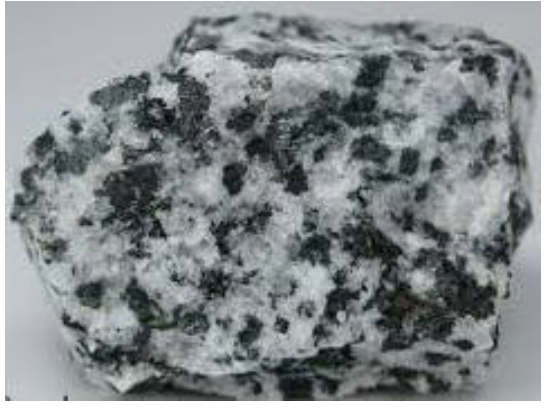
Granite
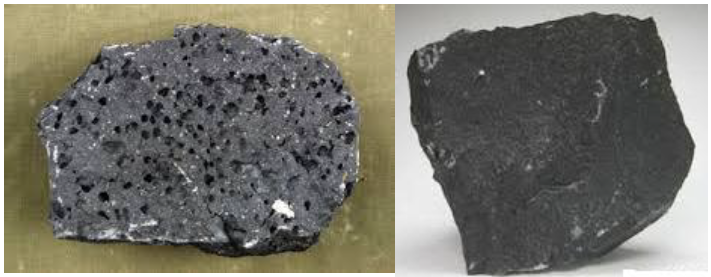
Basalt rocks
Sedimentary rocks
Sedimentary
rocks are found in layers; they contain fossils and are very soft.
These are weathered particles formed through deposition and
lithification processes. Sedimentary rocks are formed when the sediments
are accumulated, compacted and cemented together. The sediments are
compacted by compression to form sedimentary rocks. These are called
stratified rocks.
Characteristics of sedimentary rocks
- They are formed when particles or sediments are accumulated, compacted and cemented together.
- They contain fossils.
- They are found in layers (strata).
- They do not reflect light.
- They are non-crystalline rocks.
- They can undergo metamorphic process.
Types of sedimentary rocks
Mechanically-formed sedimentary rocks
These
are formed through weathering process. When weathering agents erode and
deposit rock particles, they are accumulated, compacted and cemented
together to form sedimentary rocks. Examples of mechanically formed
sedimentary rocks are clays, gravels and alluviums (all deposited by
water), moraines, boulder clay and gravels (deposited by ice) and loess
(deposited by wind); sandstones and shale.
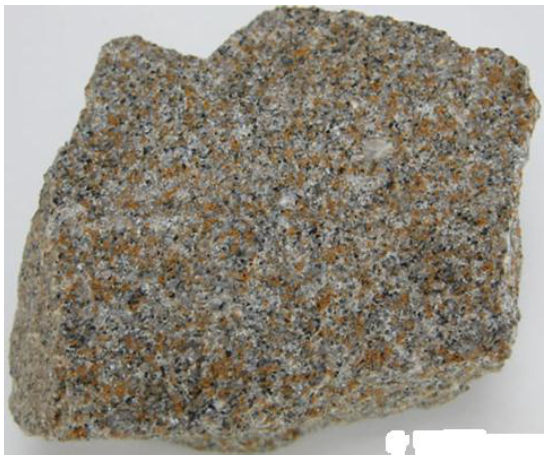
Sandstone
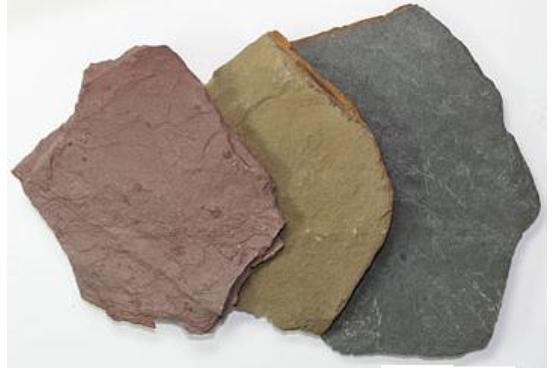
Shale: Shale occurs in a wide range of colours that include: red, brown, green, grey, and black.
Chemically-formed sedimentary rocks
These
are formed through chemical precipitation process. They include
carbonate (as it is in stalactite and stalagmite), sulphate, chloride,
etc. The main examples are gypsum, rock salt, lignite, dolomite, flint,
borax, limonite, haematite, etc.
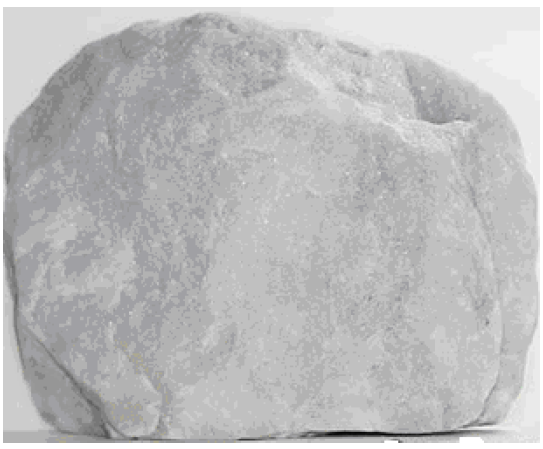
Dolomite
Organically-formed sedimentary rocks
These
are formed through mineralization process of decaying and decomposition
of dead organisms such as animals and plants. The remains of living
organisms are accumulated, compacted and cemented together to form these
sedimentary rocks. The main examples are chalk (limestone) and coral
(formed from animals), and peat, coal and lignite (formed from plants).
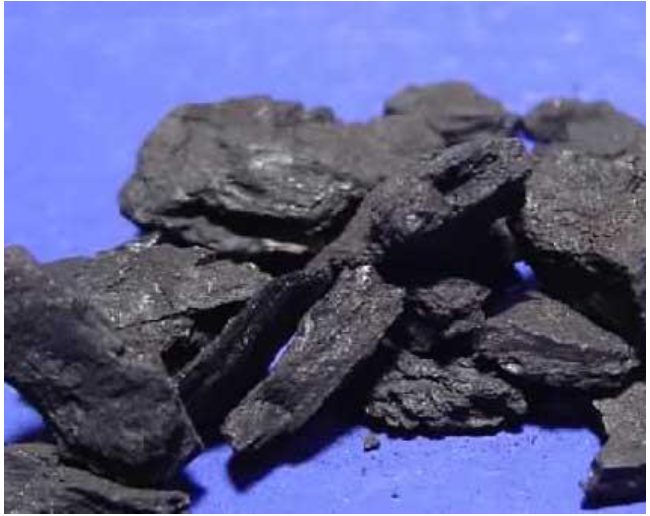
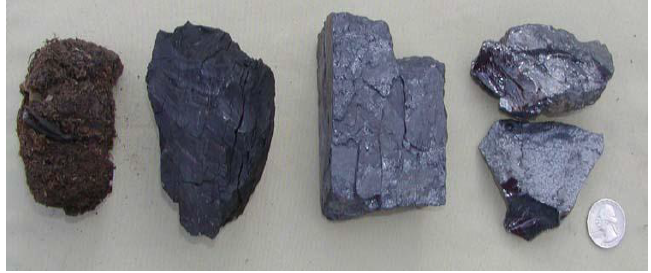
Lignite rocks
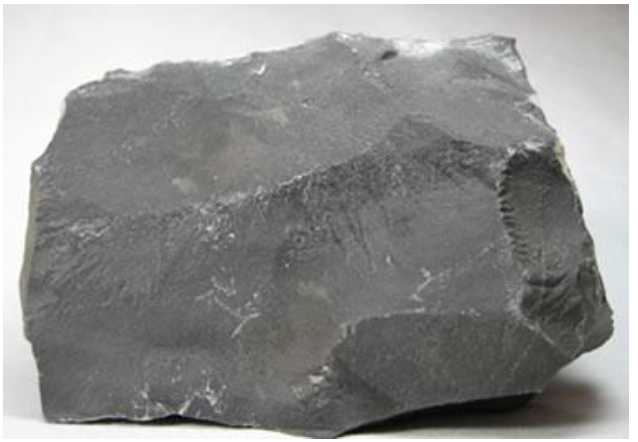
Limestone
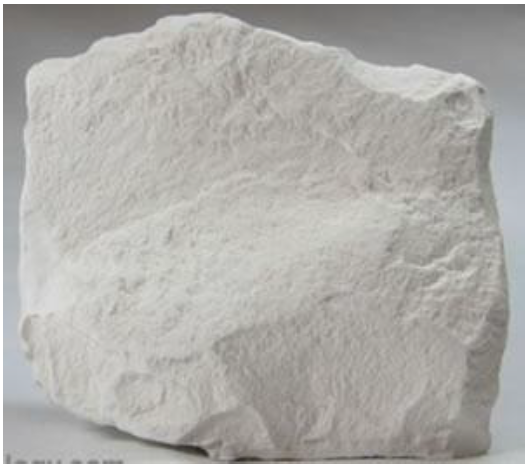
Chalk
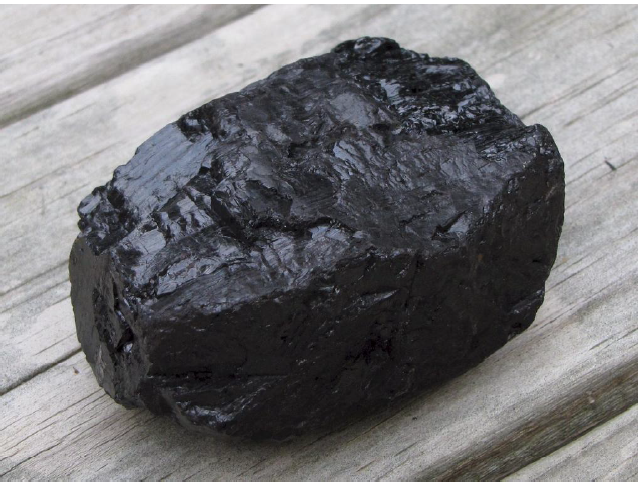
Coal
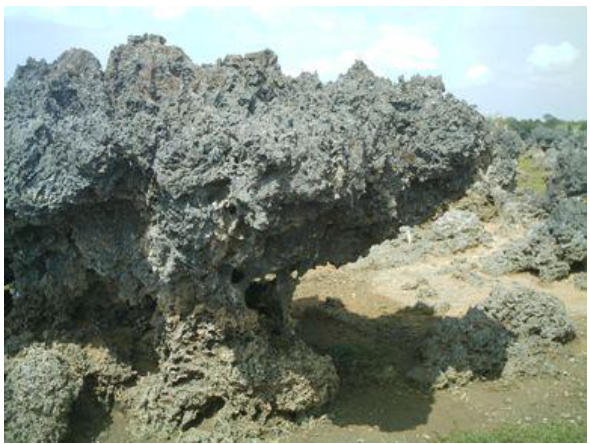
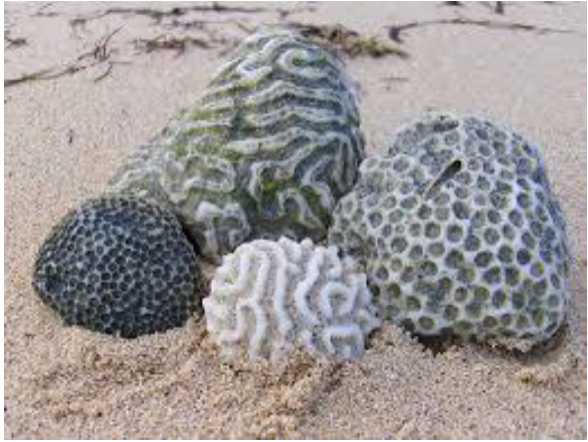
Coral rocks
Metamorphic rocks
These
are rocks which have changed their shape, size, appearance or chemical
composition due to the contact of heat, pressure or both. This process
is referred to as metamorphism. Any rock can be changed into a
metamorphic rock. Examples of metamorphic rocks are slate, marble and
granite.
Characteristics of metamorphic rocks
- They are very hard due to prolonged action of heat and pressure.
- Any type of rocks can be subjected to metamorphic rocks.
- They can undergo weathering process.
The main examples of metamorphism in rocks include the following:
- Sandstone to quartzite.
- Coal to graphite.
- Limestone to marble.
- Clay to slate.
- Granite to gneiss.
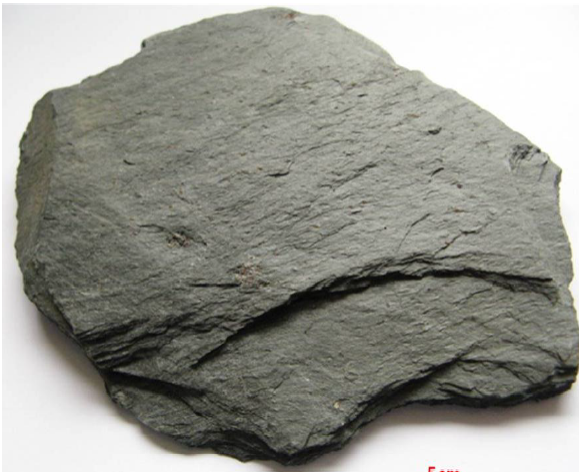
Slate
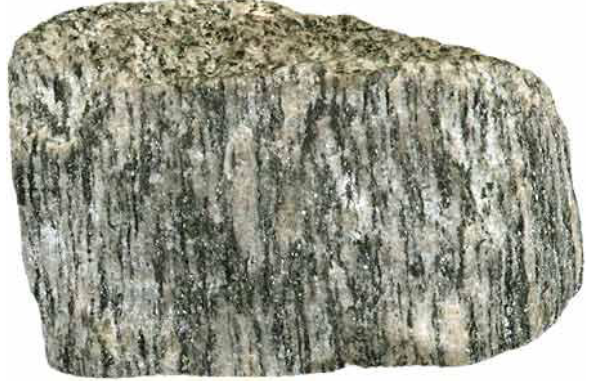
Gneiss
ROCK CYCLE
This
is the cycle in which rocks tend to change from one type to another.
For instance igneous rocks may change to metamorphic rocks or
sedimentary rocks; sedimentary rocks to metamorphic or igneous rocks,
etc. It is a relationship in which rocks tend to change from one type of
rock to another.
Necessary conditions for rock cycle to take place
- First, the molten rocks erupt from the interior of the earth and then cool and solidify to form igneous rocks.
- Secondly, the igneous rocks are subjected to denudation process to form sedimentary rocks.
- Third, either igneous or sedimentary rocks undergo metamorphism, due to prolonged heat and pressure, to form metamorphic rocks.
- Fourth, metamorphic or igneous rocks can undergo weathering process through erosion and transportation of sediments which are further deposited in layers in the ocean or lake floors where they are cemented and consolidated to form sedimentary rocks and vice versa.
- Fifth, metamorphic or sedimentary rocks can be subjected to heat and pressure where melting take place and later cooling, due to low temperature, to form igneous rocks.
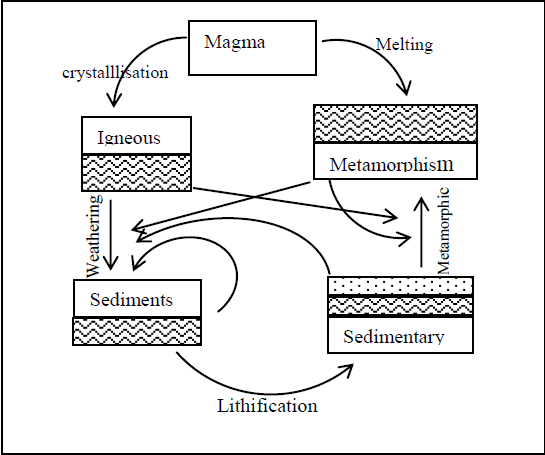
The rock cycle
Simplified geological time scale
The
geological time scale is a chart for dating the history of the earth
including rock span. It tries to explain the age of rocks as far back as
600 million years ago.
The simplified geological time scale
| Era | Period | Years in millions before present | Major geological events in Africa | Man and animals | |
| Cenozoic | Quaternary | 1 | Glaciation of East Africa mountains.Formation of river terraces and raised beaches. | Age of man | |
| Tertiary | 163 | Formation of the Atlas mountains. Lava flows in Ethiopia. | Age of mammals. | ||
| Mesozoic | Cretaceous | 135 | Deposition ofmarine sediments in the Sahara and Southern Nigeria. Formation of Enugu coalfield. | Age ofreptiles | |
| Jurassic | 180 | Break-up of Gondwanaland and Marine invasion of East Africa coastlands and separation of Malagasy Island from mainland. | |||
| Triassic | 230 | Drakensburg lavas and formation of upper Karro beds. Volcanic activity in West Africa. | |||
| Paleozoic | Permian | 280 | Formation of lower Karro beds. Formation of rich coal deposits in Tanzania and South Africa. Ice age in central and South Africa. | Age of amphibians | |
| Carboniferous | 345 | Cape fold formed. | |||
| Devonian | 405 | Marine invasion of Libya, the Sahara and Western Sudan. Continental basins formed by crustal warping | |||
| Silurian | 425 | Continental sedimentation in Zaire basin,Tanzania and South Africa, followed by intensive folding. | |||
| Ordovician | 500 | Extensive deposition of sediments.Formation of sandstones in Guinea, Mali, Volta basin and North West Ethiopia | Age of marine invertebrates | ||
| Cambrian | 600 | Marine invasion of Western Sahara and Kalahari basin. | |||
| Proterozoic | Pre Cambrian or Archarean | Glaciations of Africa South of Equator.Extensive metamorphism of oldest known fossilized, unicellular algae formed in Swaziland and Mali. | Algae |
The Mode of Formation for each Type of Rocks and their Economic Importance
The importance of rocks
- Rocks are very important in the formation of soils which can be used for agricultural production.
- Rocks are used for building purposes: some rocks such as limestone, sandstone, gravels and sand are used for building houses, construction of roads, etc.
- Some rocks are used as sources of energy or fuel such as coal and petroleum (mineral oil).
- Limestone is widely used for cement manufacturing. In Tanzania, cement is produced at Tanga, Mbeya and Wazo Hill.
- Salt extraction: salt usually originate from rock accruing strata, for instance, in Tunisia and Morocco there are large deposits of salt.
- Manufacture of chemicals: some rocks contain nitrate or phosphate, while others have potash. This kind of rocks can be used for making dyes, fertilizers and medicines.
- Mineral deposits: mineral ores occur in veins of some rocks such as igneous rocks. The minerals are formed when the magma coos down. Valuable minerals extracted from rocks include gold, lead, tin, silver, diamond, copper, zinc, aluminium, calcium and manganese.
- Some rocks are so impressive such that they attract tourist to come and view them. In so doing, the country earns a lot of foreign exchange.
- Some rocks are used for decoration of houses as ornaments or they are grinded to produce powder which is used for decoration.
- The geological time scale(GTS) is a system of chronological measurement that relates stratigraphy to time, and is used by geologists,paleontologists, and other Earth scientists to describe the timing and relationships between events that have occurred throughout Earth’s history.
Comments
Post a Comment